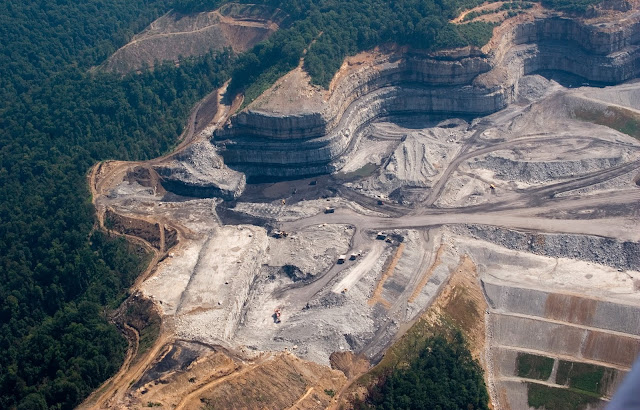Spatial Injustice in Rural Appalachia: From Geography to Internet, Health and Disease, America's White Discrimination
Katie’s post on “Food Sovereignty and Spatial Justice in Appalachian Ohio” made me
think about a broader way in which Spatial Injustice impacts people who live in
less accessible geographical areas. This is the case of the people from the Appalachians that lack the Spatial links and Spatial Power in their right to
thrive.
If there was a study done on the geographies
of the Appalachian people linked to the rise of coal industry as the study that
Rashad Shabazz did on the black migration, it will be easier to understand how
people that live in the Appalachians in many cases were migrants who followed
the coal industry jobs of the coal cities, and that were left in abandonment
and scarcity when the coal mines were exhausted.
They not only worked in very
harsh conditions in the mines, without health protections, very low paid,
having to buy their food from the mine owner who owned the marketplace at their
towns, but when the mines were depleted their surroundings were left damaged
forever. Agriculture was then impossible if not dangerous for the produce could
be polluted.
When I fist got to Athens in 2017, during my first semester of class I took a Quantitative Research
Methods class for my Communication and Development Master where we had to do an
actual research in the area. My group chose to do it on the digital gap or
digital divide in the Appalachians.
We found that most people in the rural areas
of the Appalachia have a very defective internet by satellite dish that did not
allow them to have a fluid internet experience. The reason was that there were
not internet companies willing to invest in the expensive infrastructure that
will be needed to be placed in a geographical uneven terrain such as the Appalachians, and where communities and houses are so far apart.
The State of Ohio was
trying to incentive private companies to make the investment, but the other
problem was that there is no guarantee they will get the minimum amount of
customers they will need, as Appalachians for the most part do not rely a lot
on internet (precisely because they do not have a good experience with it) and
because of this, they lack the internet skills and literacy to take the best
advantage of it or even feel is a service they need and they will be willing to
pay an average of 50 dollars a month. And that is the other problem with the Appalachians, where poverty and unemployment rates are above the national
average in Appalachia Ohio.
After reviewing this class literature, I can
clearly see how social and spatial injustice is taking place against the
Appalachian people for not having the availability and thus the skills to
access the internet and better they lives by taking advantage of all the
services and/or products offered to an average American. Specially nowadays
that many government services, health services, employment opportunities, etc.
are managed through the internet; as well as social and intimate interactions
produced through it.
The Appalachians then, lack Spatial Links in the form of
virtual links thorough the internet, but also lack of links in the form of
access to resources, including health services institutions that are usually
far away from them. This is one of the reasons why cancer in the Appalachians is usually a death center. Because they don’t usually have check ups to find the
cancer on time, they don’t have the health coverage or money for the medicines,
and their access and links to school and better jobs is also very limited.
This
is also why they have a high rate of smokers related to lung cancer, and heart
disease and diabetes linked also to their poor nutritional habits; and of
course there is the opioid crisis in the area which is high and a symptom of
their situation. They are spatially disconnected from the benefits and access to
resources any average urban American has. And what is most impressive to me,
coming from South America, is to witness that the United States, one of the
most powerful countries in the world, has such a neglected population right in
their backyard.
It has been 55 years since in 1964 president Lyndon
Johnson visited the Appalachians and declared there the war on poverty, but
spatial injustice in the form of their limited access to resources, mobility,
links and opportunity to thrive still lingers in rural Appalachia.
Bailey, K., Lobenstine, L., &
Nagel, K. (2012). Spatial justice: A frame for reclaiming our right to be,
thrive, express and connect. The Design Studio for Social Intervention
with the Generous Support of the Praxis Project, 1-21.
Rashad Shabazz: 'Why Geography Matters in the Struggle
for Racial Justice'. MPR News https://www.mprnews.org/story/2016/02/09/mpr_news_presents





The geographical isolation of Appalachia makes the region very culturally distinct and unique from other parts of Ohio. One spot that comes to mind every time I hear of coal mining in southern Ohio is the Moonville tunnel and the hiking trail in Vinton County. I'm sure many people in this class have already visited there but nevertheless the history is really interesting and its definitely worth checking out.
ReplyDeleteIt's also been commented on quite a bit in urban planning and geography related courses here at Ohio University in regards to the history of coal mining and coal pollution within the Ohio River Valley. The pollution from this is still something the region's recovering from today. With many superfund sites in West Virginia and Ohio in states of remediation or recovery. today.